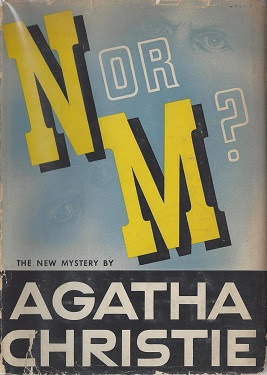N or M? is a work of detective fiction by Agatha Christie first published in the US by Dodd, Mead and Company in 1941 and in the UK by the Collins Crime Club in November of the same year.
The US edition retailed $2.00[2] and the UK edition at seven shillings and sixpence . The title is taken from a catechism in the Book of Common Prayer which asks, "What is your Christian name? Answer N. or M."[4] The "N. or M." here stands for the Latin, "nomen vel nomina", meaning "name or names". It is an accident of typography that "nomina" came to be represented by "m".
The novel is the first to feature the mature versions of her detectives Tommy and Tuppence, whose previous appearances had been in the adventure The Secret Adversary (1922) and the short story collection Partners in Crime (1929).
| Agatha Christie N or M |
INTRODUCTION
After the outbreak of the Second World War and many years after they worked for British intelligence, Tommy and Tuppence Beresford feel useless and sidelined. When Tommy alone is approached to go undercover once more, however, Tuppence decides to join him on his mission whether invited or not. Through good sleuthing she learns where he is to be sent and actually arrives there before him. They begin a search for German fifth columnists. Another British agent that was following these Germans left a cryptic message on his deathbed: "N or M. Song Susie". Grant knew that "Song Susie" stood for Sans Souci, a hotel in (fictional) seaside Leahampton, based on Bournemouth; "N" and "M" were two German spies, one male and one female. Tommy is to go to Sans Souci to investigate whether N, M or both are at the hotel and to figure out their identities.
Both N and M's identities are revealed at the end of the book; "N" is a top German spy—who is shot by British intelligence at the book's conclusion as he threatens Tuppence's life—and "M" is his female co-conspirator.
LITERARY SIGNIFICANCE AND RECEPTION
Maurice Willson Disher's review in Mr Robey has said before now, N or M? gets you.
Maurice Richardson in a short review in the 7 December 1941 issue of The Observer wrote: "Agatha Christie takes time off from Poirot and the haute cuisine of crime to write a light war-time spy thriller. N or M is [an] unknown master fifth columnist concealed in [the] person of some shabby genteel figure in Bournemouthboarding-house ... Christie's bright young couple, now middle-aged but active as ever, are nearly trapped. Nice surprise finish and all-round entertainment.
A short review by E.R. Punshon in The Guardian of 30 December 1941 ended with "Mrs Christie shows herself as ingenious as ever, and one admires especially the way in which the hero snores himself out of captivity.
Robert Barnard: "The Beresfords contribute their intolerable high spirits to the war effort. Less racist than the earlier thrillers (in fact, some apology is made indirectly) but no more convincing.
MI5 INVESTIGATION OF CHRISTIE
Around 1941 or 1942, the British intelligence agency MI5 temporarily investigated Christie herself as she had named one of her characters in this novel as a certain Major Bletchley. MI5 was afraid that Christie had a spy in Britain's top-secret codebreaking centre, Bletchley Park. MI5's fears were eventually assuaged when Christie revealed to Dilly Knox, who helped break the Enigma machine cypher used by German secret service officers sending spies to Britain, that Bletchley was merely the name of "one of my least lovable characters".
